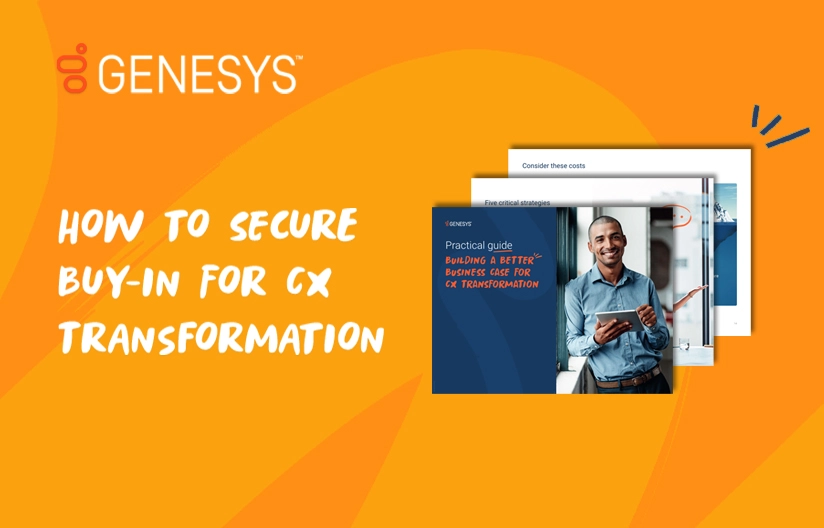Your Genesys Blog Subscription has been confirmed!
Please add genesys@email.genesys.com to your safe sender list to ensure you receive the weekly blog notifications.
Subscribe to our free newsletter and get blog updates in your inbox
Don't Show This Again.

In an industry where every second counts and the push for change is constant, it’s essential to get buy-in for new processes and technology quickly and completely. During Customer Contact Week Nashville 2022, customer experience (CX) leaders from a variety of industries shared their approaches to building consensus and excitement for new CX initiatives.
Focus on simplicity. Marriott has been on a journey to be the world’s favourite travel company. Integral to this is “empowering our associates to create unique, memorable and personalised experience,” said Karen Mitchell, the hospitality company’s Director of Service Enablement, during her session, “How to Optimise Agent Technology to Reduce Cost and Transform CX.”
To achieve this goal, Mitchell “invited agents to join them on the journey” by asking them to be open and to communicate any concerns and recommendations they might have. Mitchell also understood that CX transformation requires emotional alignment, so she launched a change management team to help associates deal with all the changes they’d encounter.
She and her team worked to minimise distractions while acknowledging disruptions. There will always be challenges, she said, so it’s best to be upfront, set expectations and listen to users.

Focus on fundamentals. For most of the 50 years it was in business, Lendlease lacked a formal customer strategy. When Bradly Sax joined the property development and management company as Vice President of Customer Strategy and Execution, he changed that.
During his session, “4 Principles to Optimise Customer Experience,” Sax shared a few of his secrets for how CX leaders can gain buy-in by focusing on the basics.
Frontline leaders need to have a clear vision that fosters a customer-centric culture for making strategic decisions, he said. And they need to communicate that with their teams and be sure they understand. It’s about setting supporting goals and measuring outcomes — not just customer satisfaction and Net Promoter Score, but also churn rate, acquisition costs and quality assurance.
And the leaders need to listen to associates, partners, customers and peers — and take their concerns and opinions into account when making decisions.
CX leaders also need to hire for the right personality fit, and then train for skills, said Sax. He recommended continually engaging team members, which isn’t about parties and lunches. Instead, they want managers to be interested in them, provide them with ongoing training and development, and support them by listening and empowering them. CX managers need to provide feedback and celebrate team members’ efforts — “when things go horribly wrong as much as when they go right,” he said.
Focus on clarity. Change can be tough for any organisation. But when a company has been doing something the same way for years, driving change can be exceptionally difficult.
Philip Bennett, Customer Service Operations Manager at Empire-Today, overcame that obstacle by being clear about goals, expectations and outcomes, he said during his session, “Leveraging Next-Generation Technology to Improve the Customer Journey.”
Bennett emphasised the importance of understanding the company’s political landscape to know which stakeholders to engage and what information and outcomes they’ll want. It’s also critical to know any concerns they might have.
He noted the importance of using data to support his recommendations, showing early wins worth building on, and taking advantage of opportunities to test and learn.
He also worked with key stakeholders to define success before making changes. Just as essential, he said, was collaboratively defining terms that colleagues might not understand or think of differently. “Even a call,” Bennett said. “When does it start? When the customer calls or when an agent picks up?” Those items need to be clear.
Bennett also has a recovery plan ready when making any significant process or technology changes. This helps build stakeholder confidence in taking risks and trying new approaches.
Focus on employee engagement. “We believe the client experience will never be better than the employee experience,” said Will Lombardi, Vice President of Service and Operations at Northwestern Mutual during his “Empowering the Customer Service Professional of the Future” session. “You won’t have a great employee experience without leadership excellence,” he added.
When looking for ways to improve the customer experience, Lombardi started with one simple internal modification: calling contact centre agents “service professionals.” That small change made a huge impact on employee engagement, which spilled over into more engaged customer interactions.
He also made it clear how much the business values those service professionals. Lombardi explained that there’s a value chain at Northwestern Mutual: leadership excellence, employee excellence, client experience and business results. “All of them are equal links in the chain,” he said.
In today’s environment, transformation is an ongoing journey for employees and managers, so Northwestern Mutual also has three coaching academies: one for its service professionals; one for supervisors and managers; and one for facilitators to help them understand how to build, engage and retain teams. The academies also show how interactions come to life — to help participants experience new processes or interaction types in a comfortable space before experiencing them during live interactions.
Whether a company is streamlining processes or implementing new technologies, it’s crucial to get buy-in from the users and other stakeholders at the centre of the transformation. CX leaders who adopt and adapt the approaches these executives shared will experience a smoother transition and better outcomes.
To see how Genesys can help you gain buy-in for your CX transformation, check out our practical guide.
Subscribe to our free newsletter and get the Genesys blog updates in your inbox.